Charts of the Week
Current economic trends from 22 to 26 March 2021: fiscal verification of invoices, electricity consumption, traffic of electronically tolled vehicles, registered unemployment and other charts
With the relaxation of containment measures, confidence in trade continued to improve in March; in services it was unchanged after rising in the previous two months. Data on fiscally verified invoices point to high year-on-year turnover growth in the third week of March, which mainly arose from trade, as most non-essential shops were closed in this period last year. The easing of measures has also led to a fall in unemployment, which strengthened somewhat further at the end of March due to seasonal factors. Confidence in manufacturing and construction, which were not affected much by the second wave of the epidemic, rose above pre-epidemic levels. Favourable developments in industry were also indicated by electricity consumption and freight traffic on Slovenian motorways, which in the third week of March were close to the levels of the comparable pre-crisis year 2019.
Fiscal verification of invoices, March 2021

According to data on fiscal verification of invoices, turnover declined sharply in the second week of March; in the third, it was considerably higher year on year due to the low base. The greater turnover fall in the second week of March was largely a consequence of the relatively significant year-on-year decline in retail trade, as last year before the declaration of the epidemic households mainly stockpiled food, beverages and toiletries. Turnover in the sale of motor vehicles and wholesale trade remained higher year on year. The year-on-year fall in accommodation and food service activities (in bars and restaurants) declined relative to previous weeks due to the opening of bar terraces and gardens. Strong year-on-year growth in turnover in the third week of March was mainly a consequence of high growth rates in trade, as last year all non-essential shops were closed in this period. However, some service activities were (partly or completely) closed, so total turnover was still 2% lower than in the comparable week of 2019.
Electricity consumption, March 2021
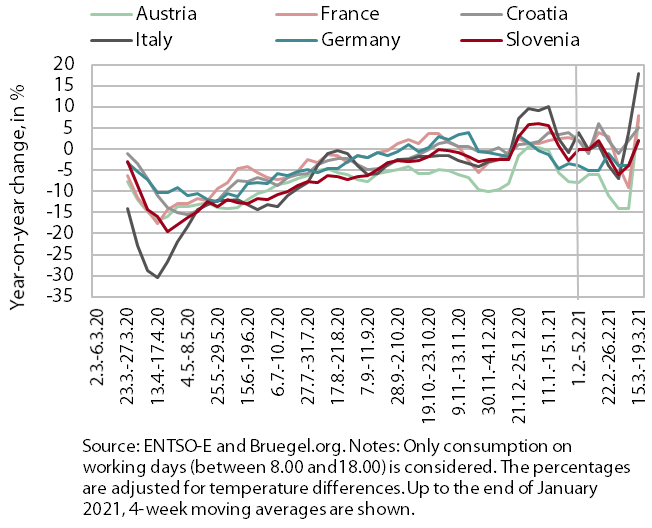
Electricity consumption in the third week of March was 2% higher compared with the same week of 2020, but 4% lower compared with the same week of the pre-crisis year 2019. Year-on-year higher consumption was also recorded in our main trading partners, from 2% in Germany to 18% in Italy. The main reason was the base effect, as last year electricity consumption dropped notably as a result of the stringent containment measures adopted at the beginning of the epidemic. Compared with the same week of 2019, most countries recorded declines. The largest was in Italy (7%), in Austria it was 4% and in France and Germany 2%. The exception is Croatia, where consumption was 4% higher with regard to the comparable week in 2019.
Traffic of electronically tolled vehicles on Slovenian motorways, March 2021
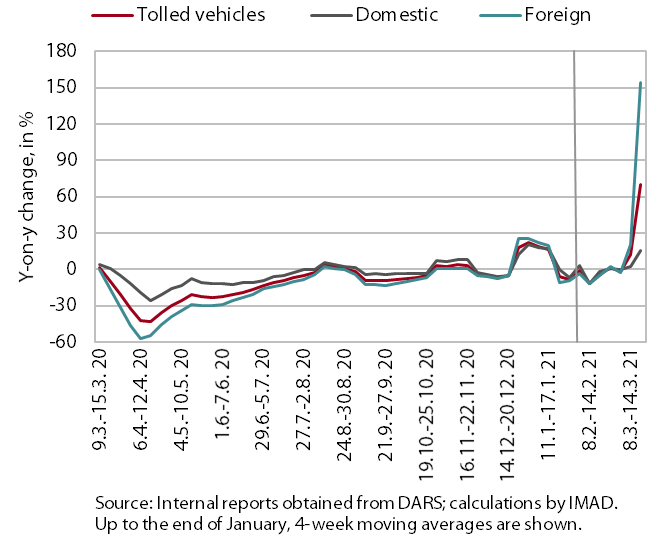
Freight traffic on Slovenian motorways in the third week of March was 70% higher than in the comparable week last year, when strict containment measures were already in force due to the beginning of the first wave of the epidemic. Between 15 and 21 March, domestic vehicle traffic was 16% higher and foreign vehicle traffic as much as 154% higher year on year. Although in the third week of March the volume of freight traffic remained high, this strong growth is mainly a consequence of the base effect, given that traffic dropped sharply in the same period of last year. Freight traffic was approximately the same as in the comparable week of 2019 (somewhat higher in domestic and somewhat lower in foreign vehicles).
Registered unemployment, March 2021
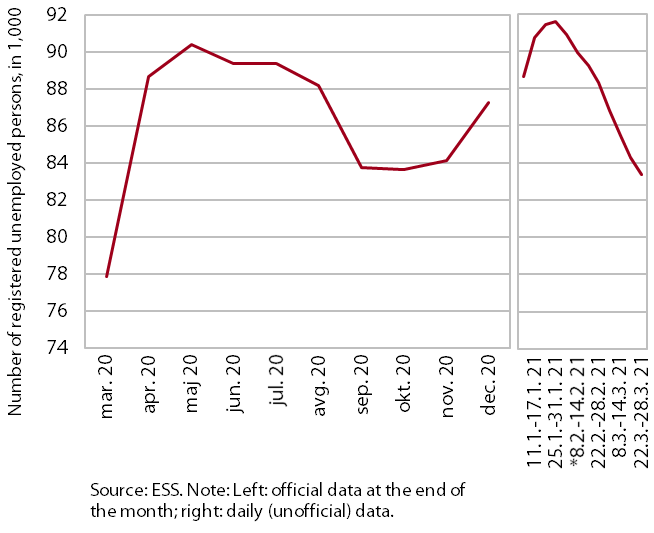
The decline in the number of registered unemployed persons strengthened somewhat further in March. After December’s and January’s increase in the number of unemployed, which did not deviate significantly from seasonal increases in the same period of previous years, the number of unemployed dropped seasonally adjusted in February. In March, its decline strengthened somewhat further, which, in addition to seasonal factors, is also attributable to the easing of measures. On 25 March, 83,076 persons were unemployed according to ESS unofficial (daily) data, which is 5.7% less than at the end of February and around 7% more than in the same period last year.
Economic sentiment, March 2021
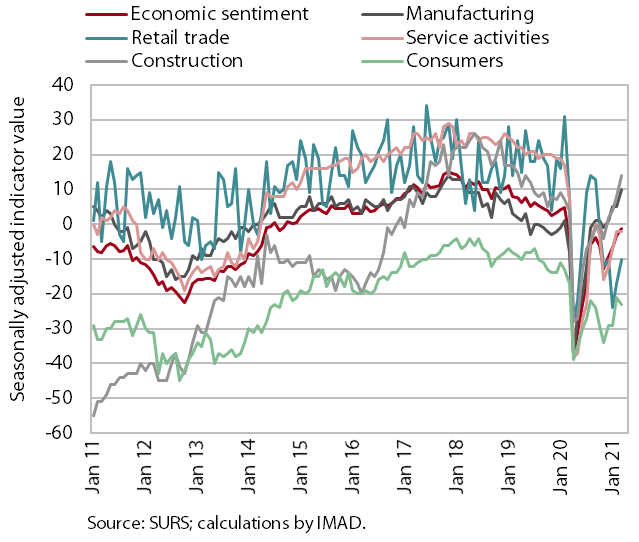
Economic sentiment improved further in March. Confidence in the export part of the economy and construction, which were not markedly affected in the second wave of the epidemic, again improved notably in March and was higher than before the epidemic. With the relaxation of some containment measures, confidence also improved significantly at the monthly level in the more affected trade, while in service activities the indicator stopped rising after two consecutive months of growth. Confidence among consumers, who are mainly pessimistic about the future economic situation, deteriorated in March and was, as in trade and services, lower year on year.
Real estate, Q4 2020
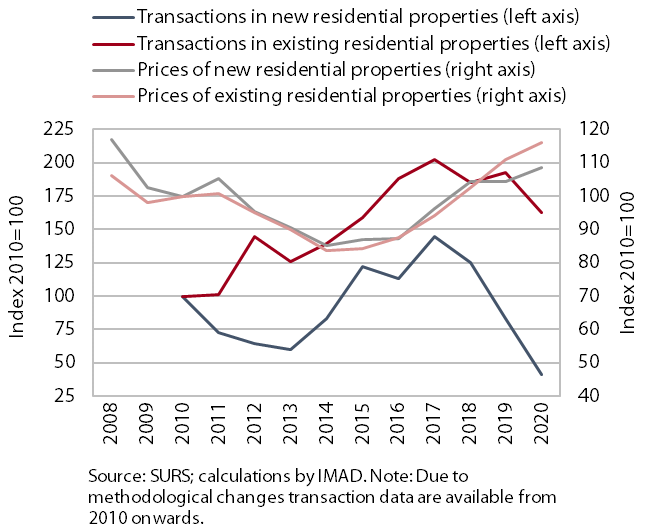
Growth in dwelling prices moderated somewhat in 2020 on average; the number of transactions declined further due to containment measures. In the year as a whole, prices were 4.6% higher year on year (in 2018 and 2019, 8.7% and 6.7% higher, respectively). They rose particularly due to higher prices of existing dwellings, in particular flats (5.4%). Prices of existing flats outside Ljubljana increased more (6.5%), for the third consecutive year. Last year, they exceeded the average 2008 price by a fifth. Prices of existing flats in Ljubljana, which started to rise earlier than in the rest of Slovenia, exceeded the 2008 level by 7.3%. Prices of newly built dwellings were also higher year on year, but these dwellings accounted for less than 3% of all transactions. Prices of family houses recorded strong growth (over 13%), but they remained lower than in 2008 (by 14.6%). The growth of prices of new flats was down (by 2.1%), the number of transactions in these flats being at an 11-year low.
